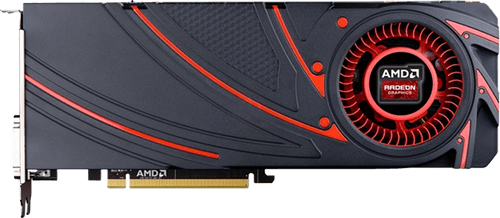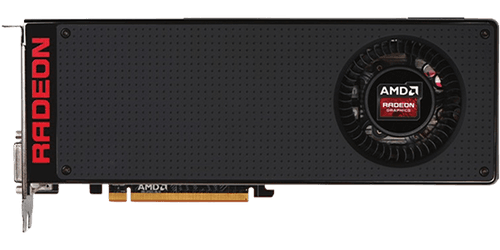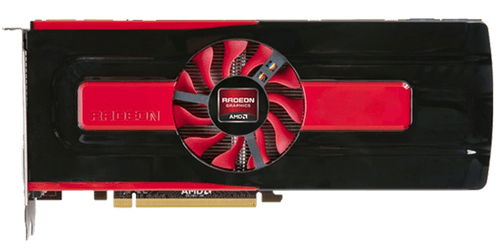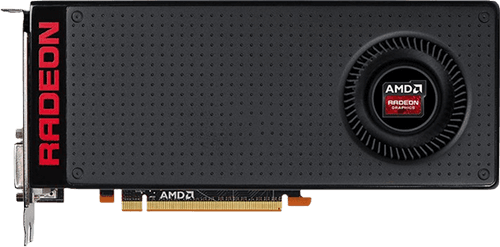AMD Radeon R9 290X

amd
Brand2816
Cores4GB GDDR5
Memory Size2816 : 176 : 64
Shaders/TMUs/ROPs512 Bit
Memory Bus320 GB/s
Bandwidth
AMD Radeon R9 290X
Techinical Specs
Overview
Manufacturer
amd
Release Date
2013
Launch Price
$ 549
GPU Name
Hawaii
GPU Varient
Hawaii XT (215-0852000)
Architecture
GCN 2.0
Foundry
TSMC
Process Size
28 nm
Transistors
6200 mil
Perofrmance
Pixel Rate
64 GPixel/s
Texture Rate
320 GPixel/s
FP16 Performance
TFLOPS
FP32 Performance
5.632 TFLOPS
FP64 Performance
704 GFLOPS
Memory
Memory Size
4 GB
Memory Type
GDDR5
Memory Bus
512 bit
Bandwidth
320 GB/s
Features
DirectX
12
OpenGL
4.6
OpenCL
2.1
Vulkan
Shader Model
6.5
Render Config
Shading Units
2816
TMUs
176
ROPs
64
RT Cores
L1 Cache
16 KB
L2 Cache
1.00 MB
Design & Requirements
Memory Size
4 GB
Length
275 mm
Width
109 mm
TDP
290 W
Required PSU
600 W
Connection Outputs
1x 6-pin + 1x 8-pin
Power Connectors
2x DVI, 1x HDMI 1.4a, 1x DisplayPort 1.2
Simillar Performing GPUS

Radeon R9 390X
2015
8 GB
GDDR5
$ 429

Radeon HD 7950
2012
3 GB
GDDR5
$ 449

Radeon R9 380
2015
2 GB
GDDR5
$ 199

GeForce RTX 4060
2023
8 GB
GDDR6
$ 299

GeForce GTX 1660
2019
6 GB
GDDR5
$ 219
Performance in Benchmarks

3DMark

Geekbench 5

PassMark
Performance in Games



World War Z



The Sinking City



Apex Legends



The Outer Worlds



Beyond Two Souls



Need for Speed Payback
No more benchmarks available for this GPU
Performance Review Summary
Generating AI Review...
AMD Radeon R9 290X
Graphics Card
$549

PCBench Rating in 2025
Based on comprehensive benchmarks and real-world performance data analyzed by our custom AI algorithm.
AI Summary
AMD’s Radeon R9 290X was a 2013 high-end card, but in 2025 it delivers mainly 1080p High performance with frequent dips in demanding titles and limited headroom at higher resolutions. It averages around 60–80 FPS in lighter or well-optimized games at 1080p High/Ultra, but struggles in heavy titles like Assassin’s Creed Odyssey where it falls to 25 FPS at 1080p Ultra. At its recorded $549 price, it’s poor value compared with far newer, faster GPUs; today it only makes sense for legacy builds targeting 1080p High with medium-to-heavy settings tweaks.
Pros
- Playable 1080p High in many games: 61 FPS in Mass Effect™: Andromeda Deluxe Edition, 81 FPS in STAR WARS™ Battlefront™ II, 72 FPS in Call of Duty®: WWII
- Solid showing in some modern-but-optimized titles at 1080p Ultra: 71 FPS in Devil May Cry 5, 73 FPS in World War Z
- 4GB GDDR5 allows many 1080p textures and high presets without immediate VRAM crashes in these tested titles
- Synthetic scores still midrange by legacy standards: PassMark 8530, 3DMark 3819
Cons
- Poor value at $549 in 2025; newer cards like GeForce GTX 1060 6 GB offered similar-or-better efficiency at far lower launch prices, and modern $249–$299 parts widely surpass it
- Struggles in demanding games: only 25 FPS at 1080p Ultra in Assassin's Creed® Odyssey and 30 FPS at 1080p High in Tom Clancy's Ghost Recon® Wildlands
- Weak 1440p and 4K performance: e.g., 36 FPS at 1440p Ultra and 20 FPS at 4K Ultra in Shadow of the Tomb Raider: Definitive Edition
- Only 4GB VRAM limits future titles and high-resolution textures; stability and settings headroom will be constrained
- Inefficient versus contemporaries: lower PassMark than same-price GeForce GTX 980 (8530 vs 11113) and trails many later midrange GPUs at a fraction of the cost
Most Compared GPUs
Comments & Discussion
Share your thoughts and experiences